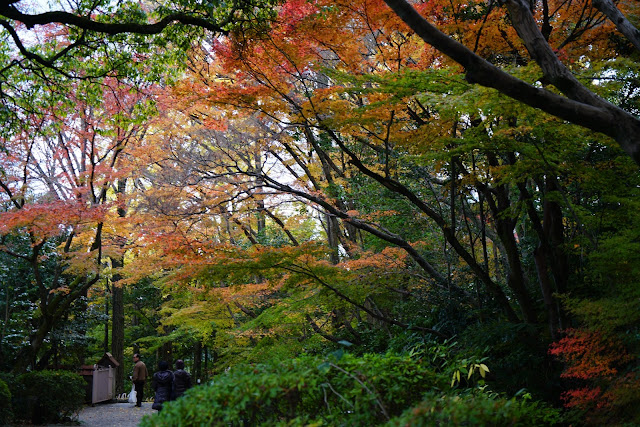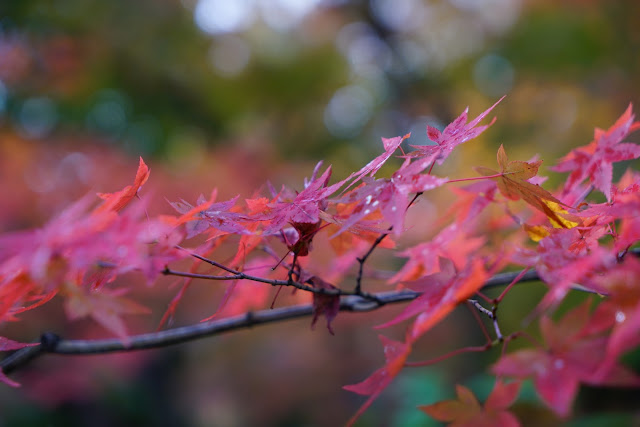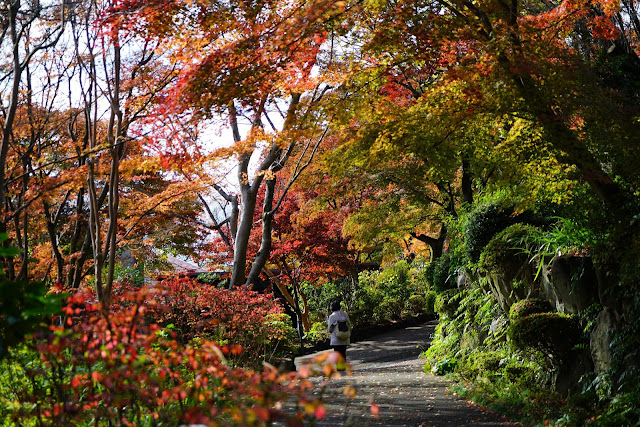On day two of my visit to Kyoto, I decided to visit a place which doesn't always display some of its precious art collection just at the time you are visiting it. It's the Asahi Beer Oyamazaki Villa Museum of Art. The building there used to the country retreat of Shotaro Kaga (1888-1953) a wealthy business from the Kansai area and founder of the Nikka Whisky Distilling who later gave his shares in the company to his close friend Tamesaburo Yamamoto, the first president of Asahi Breweries. Kaga was a man of fine taste, an avid cultivator of orchids and had even written a book on woodblocks of that beautiful flower called "Rankafu" Kaga died in 1953 but his wife continued living there until 1967, when she too died and the Kaga family decided to sell it. After several changes of hands, the new owners decided in 1989 to tear it down and replace it with some new luxurious apartments. But the local residents objected and started a campaign to save it and evedntually the local governments of Oyamazaki and Kyoto decided to restore it and reopen it as an art museum, something which came to fruition in 1996. As part of the 20th anniversary celebrations of the founding of the museum there, it's now showing some of its Monet collections.

First, I got to take the Kyoto-Oyamasaki train and discovered to my surprise that in Kyoto, unlike in the metro in HK, there are many more overhead hand rings in the train compartments with different lengths to accomodate people of different height.

As I got down the stairs at the Oyamazaki station, I found a huge advertisement of the Yamazaki Distillery which I planned to visit in the afternoon.

This is the tiny train station

across the railways line, I could see a yellowing ginko tree above the reddening maple trees..

But I had to pass through this railroad crossing which would send out what sounds like an air-raid siren whenever a train is coming from either directions.

This is the road sign at the side of the road leading up to the art museum

To the left is what's left of the original place where some famous lectures would be delivered.

A plan of the area of Mount Tennō

It was a beautifully tree-lined road

Some onions found hanging from the eaves outside the wall of one of houses there.

You got to take your hats off to the Japanese. They even got special bins for dead red leaves!

Another map on the way up

The map introduces various paths one could take up Mount Tennō

A multi-colored pigeon close to the map

the fences are overgrown with moss

Some of the like-minded people ahead

I really enjoyed the walk up

A map plus history of the original Honnō-ji (本能寺) on the mountain

A map plus history of the original Honnō-ji (本能寺) on the mountain

Honnō-ji (本能寺) is a temple a temple of the Nichiren sect of the Buddhism(法華宗/日蓮宗)
whose honzon (本尊) is mandara-honzon (曼荼羅本尊) from the Namu Myoho Renge Kyo (南無妙法蓮華経) made famous by the Honnō-ji Incident whereby Oda Nobunaga (織田信長 )(1534-1582), who overthrew the Ashikaga Shogunate (足利幕府) who had been ruling Japan for some 2 centuries, committed seppuku(切腹) with his attendant Mori Ranmaru(森蘭丸) and his brothers when the temple was set on fire on June 21, 1582 by the forces of the traitor Akechi Mitsuhide (明智光秀) surrounding the temple The new rebuilt temple is now located near the Kyoto Shiyakusho-mae Station(京都市役所前駅).

The leaves of the mountain come in all sorts of colors

All striving for the sun with each other

many of the leaves are turning red already

Another map of the layout my destination villa

The road leading up the villa

Everywhere I cast my eyes on, I found radiant colors

The trees on the left side of the road

A close up of some of the leaves

What a nice garage

The driveway of one of the houses there

The trees there are all really quite tall
But of course, some are much younger
There were many bamboos up there too

The locker room where all back packs must be deposited as part of the security procedures

Some really red leaves. Quite a surprise. I expected to find a museum, not a beautiful hillside.

The way leading into the museum

quite a long walk

A road side pool full of fallen leaves

I was really lucky to have such a blue sky. It was still raining the previous night

Looking back at the entrance from which I came

The leaves come in all sort of shades

These look really red

the water is really clean. No wonder there are breweries in this area

Nothing but patches of different colors behind the museum

the rocks are covered with moss and the pond fringed with leaves

the sky is in the water

the leaves love the sky

a door god

Everything
is made of fine wood and tiles. The ground floor now houses the
reception, the museum shop, the former dining room, the former living
room and the former drawing room and the first floor which houses the
former guest room and the former master bedroom

a nice parabola

The leaves are just so many layers of colors

color stars in the water

stars on the the branches

the garden seen from inside a corridor

a view of the surrounding from the terrace outside the coffee room, which used to be former master bedroom

from there, one can get a glimpse of the other buildings

The roof is supported by oak pillars and girders

The clouds are gathering now

Leaves outside of the bay window

In the distance, one can see the superhighway

More and more clouds

view of the pool from the first floor

An outhouse in the garden

a blaze of colors

leaves going red

The corridor leading to the museum

Deep in thought
A woman by Arustide Maillor

The wells are all covered

Another corner of the garden

Every way one turns, one finds Asian tourists which outnumber Europeans 10 to 1

The root of this tree is covered with a blanket of fallen leaves

red leaves in the garden

red leaf on close to the root

worm eaten leaves above the pond

leaves wet with stream water
reflections of the sky
a red carp

beautiful wavelets

water lily leaves

sky split by tree branches

overhanging branches

carps in the water

How can you tell if the fishes are not happy?

a colorful sky

I just follow the crowd

colors and shapes I like

unremarkable reflectjons

the water is really clean. No wonder there are breweries in this area

as colorful in as out of water

Reds

green and red

streaking

a liquid painting
three colorful carps

The way back

Not an inch of the sky is uncovered

Not much different

a blend of the natural and the artificial

The difference of sunlight

the sun is really a magician

such warmth

a hill on fire

getting cooler

a painting?

more down to earth!

so many little birds?

age tells

such luxuriance

Tiny leaves

blue and red

Never been to a hill with such colors

even the floor are dotted with color

Don't just look up!

How did they manage to change color so peculiarly
I may
not be allowed to photograph any of the exhibits inside the villa like
furniture, the lighting fixture, the fireplace, the tiles, pottery folk art and crafts and painting collections both from Japan, China and France and Germany, collectively called the Yamamoto Collections(ie. those of Tamesburo Yamamoto, the first president of the Asahi Breweries including some "Water lilies" of Monet and even some stone reliefs from late Han dynasty in its living room), but I was more than compensated by the unexpected
beauty of the environs of the villa.







沒有留言:
張貼留言